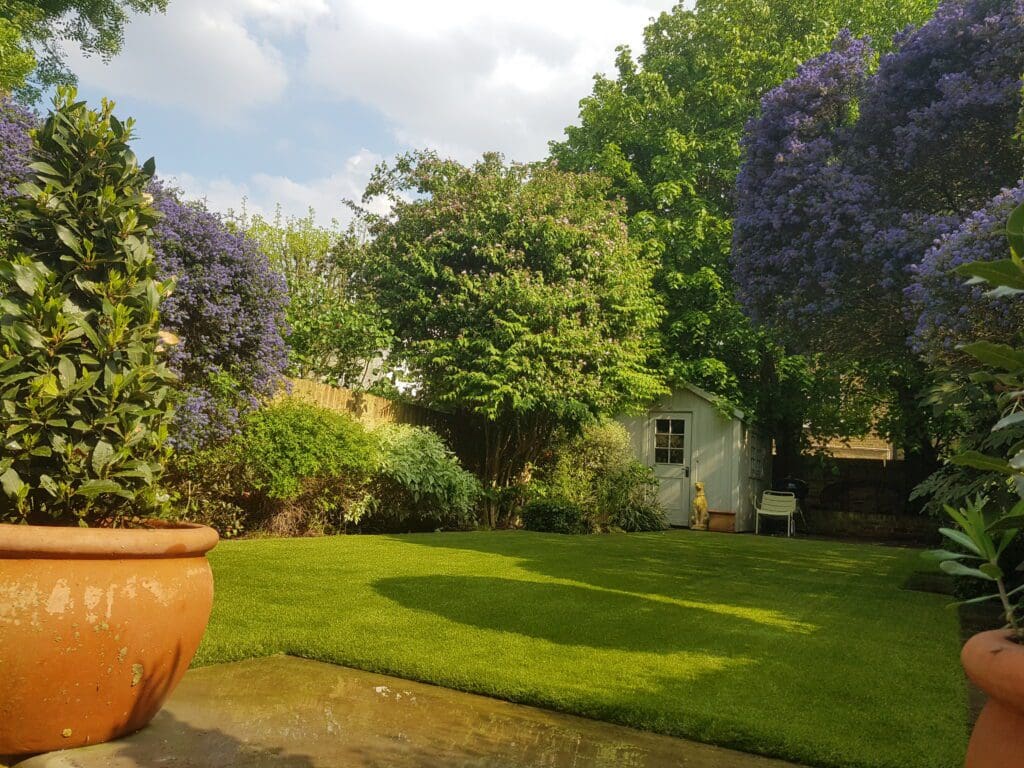This blog post will list the pros and cons of artificial grass and compare it with real grass to highlight its benefits over natural grass. Many people favour artificial grass because it’s more convenient for modern, busy lifestyles. When landscaping your outdoor space, one of the most significant decisions you’ll need to make is whether to use artificial grass or natural grass. Both options have pros and cons; the right choice will depend on your specific needs and preferences.
Natural Looking
The appearance of synthetic grass has improved vastly over time, and many higher-end surfaces have a compelling natural appearance. Our artificial turf looks and feels as good as the real thing. Our Which? Best Buy London is our most natural-looking grass and suits most gardens. While modern artificial grass is designed to look and feel like natural grass, there’s still no substitute for the real thing. Natural grass has a texture and colour that’s hard to replicate, and it can be customized to fit the specific needs of your landscape.

Maintenance
Artificial grass is a low-maintenance option that doesn’t require watering, mowing, or fertilizing. On the other hand, natural grass requires regular maintenance to stay healthy and vibrant. Artificial grass is a low-maintenance option that doesn’t need watering, mowing, or fertilizing. On the other hand, natural grass requires regular maintenance to stay healthy and vibrant.
Durability
Artificial grass is highly durable. It can withstand wear and tear, is weather-proof, does not dry out, gets waterlogged, and will not fall victim to pest infestations. It is way more robust than natural grass. Artificial grass is designed to be long-lasting and can withstand heavy foot traffic and harsh weather conditions. Natural grass can be more fragile and may require reseeding or replacement if damaged.
Environmental Impact
Our grass can be recycled at the end of its life to be repurposed into other products. This reduces landfill and waste, preserves resources, prevents pollution, and saves energy. This makes our artificial turf products highly sustainable and reduces environmental impact. Natural grass is a sustainable option that provides essential ecosystem services, such as absorbing carbon dioxide and improving soil health. On the other hand, artificial grass is made from non-renewable materials and may contribute to environmental issues like the heat island effect.
Cost
Artificial grass, also known as synthetic turf or fake grass, offers various cost benefits compared to natural grass. Here are some key cost benefits of artificial grass. Reduced Water Usage: Natural grass requires regular watering to maintain its lush appearance, especially in dry regions. This can result in significant water usage and increased water bills. In contrast, artificial grass does not require watering, as it is made from synthetic materials that do not require moisture to thrive. This can lead to substantial water savings over time, decreasing water bills and conserving a precious natural resource. Artificial grass requires minimal maintenance compared to natural grass. Natural grass requires regular mowing, fertilizing, seeding, and pest control, which can be time-consuming and costly. In contrast, artificial grass only requires occasional brushing and debris removal to keep it looking clean and well-maintained. This can result in lower ongoing maintenance costs, saving time and money in the long run.
Cost-Effective Over Time: Although the upfront cost of installing artificial grass may be higher than natural grass, long-term cost savings can offset the initial investment. The reduced water usage, lower maintenance costs, and longer lifespan of artificial grass can save costs over time, making it a cost-effective option in the long run.
Consistent Appearance
Artificial grass consistently appears throughout the year, regardless of weather conditions or foot traffic. It does not require mowing, which means no uneven growth or unsightly patches. Without ongoing lawn care expenses, this can result in a consistently attractive and well-manicured appearance.
Synthetic grass, or artificial turf, has become a viable alternative to natural grass for sports fields. This turf type is made of synthetic fibres that mimic the look and feel of natural grass, providing a consistent playing surface regardless of weather conditions. However, like any other material, synthetic grass for sports fields has pros and cons.
Pesticides and herbicides: can be expensive, and their repeated use over time can add to high costs for homeowners or property owners maintaining a natural grass lawn. Additionally, using these chemicals can have adverse effects on the environment, including contamination of soil, water, and air, as well as harm to beneficial insects, animals, and plants.
With artificial grass, there is no need for pesticides or herbicides, as the synthetic materials used in its construction are resistant to pests and do not support weed growth. This means homeowners or property owners can avoid the ongoing costs of purchasing and applying these chemicals and reduce their environmental impact.
Furthermore, eliminating the use of pesticides or herbicides can also contribute to a safer environment for children, pets, and wildlife that may come into contact with the lawn. Artificial grass provides a worry-free alternative that does not pose health risks associated with chemical exposure.
It’s important to note that while artificial grass eliminates the need for pesticides or herbicides, regular maintenance such as brushing, debris removal, and occasional rinsing may still be required to keep the turf clean and well-maintained. However, these maintenance tasks are typically minimal compared to the ongoing use of pesticides or herbicides with natural grass.
Pros of Synthetic Grass for Sports Fields:
Although installing artificial grass may be higher upfront than natural grass, long-term cost savings can offset the initial investment. The reduced water usage, lower maintenance costs, and longer lifespan of artificial grass can result in cost savings over time, making it a cost-effective option in the long run.
Penalties are furthermore to regard:
Initial Cost: The installation cost of synthetic grass can be higher than natural grass, including the costs of materials, labour, and equipment. However, the long-term cost savings on maintenance and water usage can offset the initial investment.
Heat Retention: Synthetic grass can absorb and retain heat, especially in hot climates, making the surface hot to the touch and uncomfortable for athletes during the summer months. However, advanced cooling technologies are available in some synthetic grass systems to address this issue.
Surface Hardness: Synthetic grass can have a more rigid surface than natural grass, which may increase the risk of injuries, particularly in sports involving frequent falls or tackles. However, some synthetic grass systems use advanced shock absorption technologies to mitigate this risk.
Environmental Impact: Synthetic grass is made from non-renewable materials and is not biodegradable, which can have environmental implications. However, some synthetic grass options are made from recycled materials and are more environmentally friendly.
In conclusion, synthetic grass for sports fields offers several advantages: durability, low maintenance, weather resistance, and consistency. However, some disadvantages are also to consider, such as the initial cost, heat retention, environmental impact, and surface hardness. It’s essential to carefully weigh the pros and cons of synthetic grass based on the specific needs and requirements of the sports field before deciding. Consulting with a professional landscape architect or sports field expert can provide valuable insights and recommendations for choosing the right turf type for your sports field. Artificial grass offers various cost benefits, including reduced water usage, lower maintenance costs, eliminating the need for pesticides or herbicides, longevity and durability, cost-effectiveness over time, and consistent appearance. When considering the overall costs of maintaining a lawn, artificial grass can be a financially prudent choice for homeowners and property owners in the long run. However, it’s essential to carefully evaluate the specific costs and benefits based on your individual needs and circumstances before deciding. Consulting with a professional landscape expert or artificial grass installer can provide valuable insights and recommendations for determining the cost benefits of artificial grass for your specific situation.



